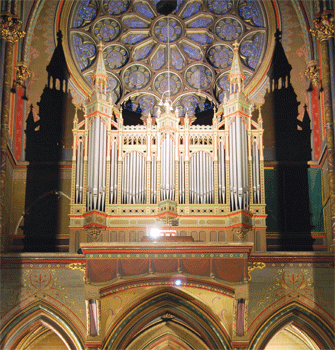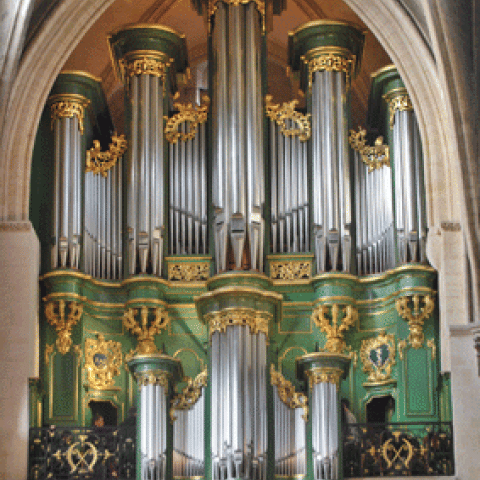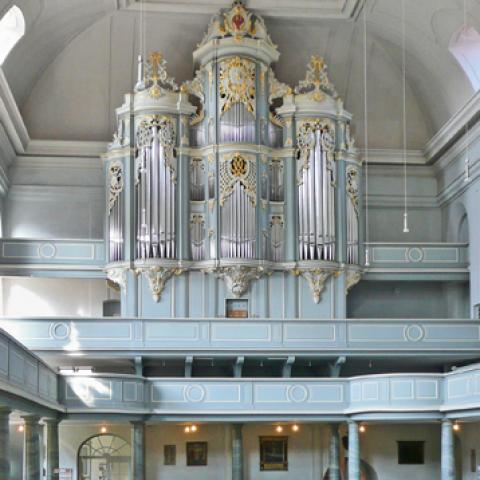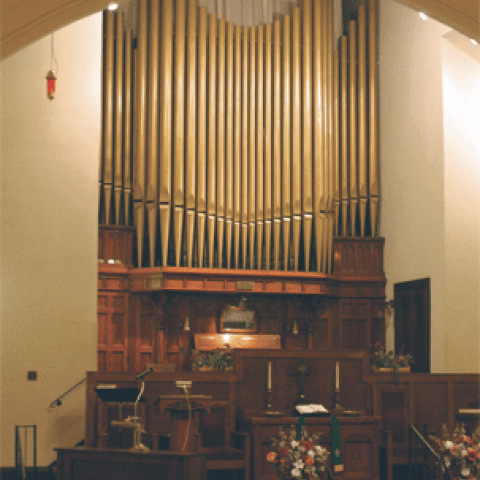Stephen L. Pinel
In 1984, William T. Van Pelt, then the executive director of the Organ Historical Society, wrote in The Tracker: Concomitant to the popularity of photography at the end of the nineteenth century was the blossoming of picture postcards that fortuitously embraced organs and church interiors among a wide range of subjects. Cards provide the examples we need to study architectonics and the visual evolution of organs, as well as traits of contemporary builders and their instruments. In some cases, a card represents the only remaining record of an organ’s existence.2
An accomplished photographer, Van Pelt had an uncanny awareness of the pipe organ as an entity of visual art. Like fine furniture, painting, sculpture, or any other form of high art, organ cases designed by organbuilders are distinctive and have identifiable characteristics. Cognizant of their usefulness for study, Van Pelt challenged the members of the OHS to search local antique and book stores for postcards showing vintage pipe organs. By the time his article was prepared for publication, ten society members had submitted more than a hundred cards. Sixteen were chosen to illustrate the article.3 In the thirty-five years since his article appeared, hundreds of organ postcards have surfaced, showing a wide variety of instruments by dozens of American organbuilders.
For context, some fundamentals of postcards may be informative. Cards are usually printed on thick paper or thin cardboard and measure approximately 3½ by 5½ inches. An image appears on the front, while the back is bifurcated—a message is written on the left with the address on the right. When mailed, postcards usually have a lesser rate than first-class postage, so they are slightly less expensive to send. Cards are often used to convey short messages, share memories of distinctive locations, or advertise events. Postcards differ from postal cards—the latter refers to those “special” cards issued by the postal service with the “stamp” already in place. Only the post office can issue postal cards. During the first four decades of the twentieth century, postcards cost a penny to mail, and were often called “penny postcards.”
While a few postcards were issued during the nineteenth century, it was not until the United States Congress passed the Private Mailing Card Act of May 19, 1898, that private individuals, companies, vacation destinations, and ecclesiastical organizations were permitted to print and distribute postcards. Previously, the United States Post Office held the monopoly. The heyday of the postcard was between 1900 and 1945, and one has only to type “postcard” into eBay.com to locate tens of thousands of cards, covering every imaginable topic the world over. Postcards are inexpensive, highly collectable, and an entire subculture has evolved around them at “swap meets” and shows of ephemera. The research value of old cards is that the subject matter may have changed or disappeared,4 and the images they display are often not found elsewhere. Stated directly, postcards are primary source documents.
There were several types of postcards. The earliest, published during the period 1900 to 1910, had a small black and white image on the front, surrounded by a white border. The address was written on the back, and if a message was included, it had to be written on the front of the card beside the image. In March 1907, the “divided back” was unveiled. This allowed for the message and the address to be written on the back, but freed the entire front of the card for the image. By 1910, postcards began to be published in color and were immediately mass-produced in huge quantities. About 1930, “linen” post cards first appeared. Those were printed on card stock with high-rag content, but the pressing of a machine gave the impression that the image was printed on linen. The most desirable cards dating from the first decades of the twentieth century were actual photographs, published on photographic paper. Those cards frequently carry high-quality images in keen focus and are eagerly sought by collectors. The final type, called the “chrome” postcard, came into circulation about 1950. They are published from a color photograph and have a shiny, glossy finish. Chrome cards are the type most often found today in souvenir shops.5
There are many ways to identify and date postcards. Some images are fully identified on the card itself. Other clues may be deduced from the postmark, since a card was often mailed from its place of origin and a date usually accompanies the postmark. Obviously, the card must pre-date the postmark. Moreover, the image may offer clues to identify the card. Many of the pipe organs pictured on postcards during the first decades of the twentieth century were new when the cards were issued. Organs were expensive, and some organ cards were produced immediately after a new instrument was installed. A few cards actually declare: “Our new pipe organ!” Finally, the style of the stamp may help to narrow the date if the postmark is either faint or incomplete. The post office redesigned stamps every few years. The older cards usually have a one-cent “Franklin,” while by the second decade of the twentieth century it was a one-cent “Washington.”
American organbuilders soon realized the reward of using postcards for promotion. The Estey Organ Co. in Brattleboro, Vermont, the Votteler-Hettche Organ Co. in Cleveland, Ohio, and the Wicks Organ Co. in Highland, Illinois (among others), distributed organ postcards. They were an inexpensive way to advertise recent installations and simultaneously impressed prospective customers. Estey was especially prolific with this method of marketing: several dozen organ cards issued by the firm have been gathered over the years. Sometimes those cards represent an important historical record because the organs they illustrate are now lost to history.
Some postcard organs are well known. This card (Illustration 1) was mailed from New York City to West Stockbridge, Massachusetts, on April 20, 1929, and shows the interior of the Cathedral of Saint John the Divine at 110th Street in New York City. The organ, Ernest M. Skinner Company Opus 150, completed in 1910, is a huge, four-manual instrument of some 150 ranks6 and was dedicated by Clarence Dickinson (1873–1969) in April 1911. Since the card was issued, the organ has been renovated several times, notably under the direction of Ernest M. Skinner & Son in 1939, and by G. Donald Harrison (1889–1956) in 1953.7 The organ was restored in 2008 by Quimby Pipe Organs, Inc., of Warrensburg, Missouri.8 This spectacular vista, photographed from high in the cathedral, looks down at the chancel and choir. It shows the Skinner organ located on opposite sides of the chancel at the triforium level and provides a vivid impression of the enormity of the space.
Another famous postcard organ (Illustration 2) is the Newberry Memorial Organ in Woolsey Hall at Yale University in New Haven, Connecticut. A large, four-manual instrument built by the Hutchings-Votey Organ Co. of Boston, the organ was opened on June 20, 1903, by a triumvirate of prominent organists: Henry Benjamin Jepson, Yale University; Wallace Goodrich, Trinity Episcopal Church, Boston; and Gaston M. Dethier, St. Francis Xavier Catholic Church, New York City.9 The organ had an early type of electro-pneumatic action designed by Hutchings employee Harry F. Van Wart. The success of the instrument earned its maker, Geo. S. Hutchings (1835–1913), an honorary Master of Arts degree from the university. The card was mailed from New Haven to Springfield Gardens, Long Island, New York, on September 10, 1910, only seven years after the organ was built. In 1915, the organ was greatly enlarged and renovated by the J. W. Steere & Son Organ Co. of Springfield, Massachusetts,10 and again in 1928 by the Skinner Organ Company.11 This circa 1908 postcard shows the original organ case before it was reworked in 1928.12
A few postcard organs (Illustration 3) had grandiose cases! This elegant example was mailed from Richmond, Virginia, to Lena, Indiana, on November 7, 1909, and shows a major, three-manual organ in the Catholic Cathedral of the Sacred Heart. It was built by John Brown (1851–1912) of Wilmington, Delaware, who opened his organ shop in 1887.13 Brown, an Englishman by birth, was in business for some twenty-five years and built many organs for congregations in the middle-Atlantic and southern United States. Located in the cathedral’s gallery with an opulent fan of radiating trumpet pipes, the case is reminiscent of the 1869 Geo. Jardine & Son organ at St. George’s Episcopal Church, Stuyvesant Square, New York City. Completed in August 1906, the Brown organ is described in detail in the Richmond Times-Dispatch, but its tubular-pneumatic playing action proved problematic.14 Only six years later, the organ was rebuilt by M. P. Möller as their Opus 1334, 1912, and the action was converted to electro-pneumatic. Later still, the organ was rebuilt again by the Tellers Organ Co. of Erie, Pennsylvania, and today, almost nothing of the original 1906 organ remains except for the front pipes. Noted historian Donald R. Traser wrote in 2002 that the organ was considered by Mr. Brown to be his masterpiece!15
Some postcards show organs installed decades before. This card (Illustration 4), sent from South Hadley to Charlemont, both in Massachusetts, was mailed on October 6, 1910. It shows the interior of the Old South Church in Boston. Visible in the gallery is an 1822, two-manual organ by Thomas Elliot (1759?–1832), built in London. Henry Corrie (1786–1858), an English organbuilder, accompanied the instrument “across the pond” to superintend its installation.16 Following its opening on November 22, 1822, Corrie remained in Boston. After working briefly for Thomas Appleton (1785–1872), he settled in Philadelphia and became the leading maker of organs in that city between 1826 and 1850.17 The Old South organ was rebuilt by E. & G. G. Hook as their Opus 246, 1859, and the projecting keydesk, shown in the card, is the product of their renovation.18 An organ from the 1820s would have had a recessed keydesk with stopknobs arranged in vertical columns at the sides. The “new” Old South Church on Boylston Street had a three-manual organ by Hutchings, Plaisted & Co., Opus 58, 1875, and later still, a four-manual organ by Ernest M. Skinner Company, Opus 231, 1915. In 1876, the 1822 Elliot organ was moved second-hand to St. Mary’s Catholic Church in Milford, Massachusetts, where it survived until it was broken up for parts about 1955.19
A circa 1910 card shows a handsome 1872 instrument (Illustration 5) in the front of the Washington Street Methodist Episcopal Church in Petersburg, Virginia.20 The maker of the organ is unconfirmed, yet it appears to be the work of Geo. Stevens (1803–1894) of East Cambridge, Massachusetts. The case bears astonishing resemblance to the 1871 Stevens organ in the First Congregational Church, Rindge, New Hampshire.21 Stevens had worked for William Goodrich (1777–1833) and following the latter’s death, set up shop in partnership with William Gayetty (d. 1839). Stevens’s organs were characterized by fine workmanship and stately cases. Stevens built another organ for a Virginia client in 1861: a two-manual instrument for the Broad Street Methodist Episcopal Church in Richmond, installed just as the Civil War began.22 The Petersburg organ remained until it was replaced with a two-manual organ by the Estey Organ Co., Opus 1205, 1913, of Brattleboro, Vermont.
Yet another card shows the sumptuous interior of Trinity Church, Episcopal, in Watertown, New York, with its elaborate Gothic tracery. The organ (Illustration 6) is Johnson & Son Opus 856, 1898, a three-manual organ with thirty registers built in Westfield, Massachusetts.23 Visible in the image is a reversed console with the organ installed in a right-hand chamber beside the chancel. The installation was completed on March 29 and the organ was first used on Easter Day, 1898. It was later replaced by Skinner Organ Company Opus 457, 1924, and was moved second-hand to the Adirondack Community Church in Lake Placid, New York, where it was installed by Buhl & Blashfield, a Utica, New York, firm.24 Johnson & Son organs were of superb quality and were among the finer organs built in nineteenth-century America.
Three postcard organs were promotional materials issued by well-known American firms. The first (Illustration 7) was built by the Wicks Organ Co., Opus 8, 1909, for the German Ev. St. Petri Church, Okawville, Illinois. The second (Illustration 8) was the work of Votteler-Hettche of Cleveland, Ohio, and was installed in the First Methodist Episcopal Church, Petoskey, Michigan. The third instrument (Illustration 9) was built by the Estey Organ Co., Opus 505, 1907, a two-manual organ for the First Congregational Church, Chelsea, Massachusetts.
University organs are also occasionally represented. This card shows the interior of the auditorium at Valparaiso University in Valparaiso, Indiana. The organ (Illustration 10), built in 1907 by W. W. Kimball of Chicago, Illinois, was a gift of the alumni and was a large two-manual instrument with tubular-pneumatic action. The card was mailed from Valparaiso to Bridgeport, Connecticut, on October 5, 1911, and the message reads in part: “We attend chapel exercises in this place at 8:30 every morning. I have only missed two mornings as yet. We are nicely settled and like it very much.” The large piano on the stage looks like the work of Steinway & Sons! The Kimball organ was rebuilt by Hillgreen-Lane & Co. of Alliance, Ohio, in 1947 and was unfortunately destroyed with the building by fire on November 27, 1956.25
Occasionally, a postcard showing an organ was distributed for parochial purposes. This handsome card (Illustration 11) from the First Reformed Church in Carlisle, Pennsylvania, reminded recipients that a “Sunday School Rally Service” was to be held on Sunday, October 7, 1906, at 2 p.m. The organ in the image was dedicated by the noted blind organist, David D. Wood of Philadelphia, on Thursday evening, October 22, 1891.26 It was built by John W. Otto (1846–1892) of Baltimore, had two manuals and pedals, and cost $1,600.27. Otto was the brother of Louise Pomplitz (1836–1924), and at one time worked for the better-known firm, the Pomplitz Church Organ Co.
A postcard mailed from Port Huron, Michigan, to Lancaster, Pennsylvania, on October 2, 1913, is a fine example of a photographic card. The organ (Illustration 12), built by Hillgreen, Lane & Co., Opus 24, 1901, is an early instrument from the firm. The company was the partnership of Alfred Hillgreen (1859–1923), a Swedish immigrant, and Charles Alva Lane (1854–1933). Ultimately, three generations of the Hillgreen family built organs in Alliance, Ohio, between 1898 and 1973. The case shown here is unusually elegant and looks splendid in this turn-of-the century edifice. Note, in addition to the Methodist communion rail, that the choir has seating for almost fifty singers. That is a luxury not many of us enjoy today. The organ had two manuals with “pneumatic couplers”28 and was opened in recital by a Mr. N. Crawthorne and other artists on Friday evening, July 26, 1901.29
Another photographic card shows an organ (Illustration 13) in the Presbyterian Church of Pawnee City, Nebraska. Built in 1908 by the Hinners Organ Co. of Pekin, Illinois, the Hinners list states that the organ had nine registers. The Hinners Co. was known for its catalog organs. A congregation could order an organ through the mail, and the purchase included a set of directions so a member of the congregation could set up the organ! Many Hinners organs were located in rural locations in the Northern Plains, particularly in Nebraska and the Dakotas.30
A third photographic postcard mailed from King Ferry, New York, on November 24, 1916, shows an organ (Illustration 14) in the Presbyterian Church built by Clarence E. Morey (1872–1935) of Utica, New York. The small, two-manual organ, his Opus 247, 1907, is recessed into an alcove at the front of the room, behind a raised pulpit platform. Visible in the cleanly focused image are only six stopknobs. Morey worked in Utica until his death in 193531 and built several hundred small organs for the rural churches of Upstate New York. His organs were well built, durable, and many still serve their congregations today after a century of use.32
Plenty of postcard organs are unidentified. Three interesting cards (Illustrations 15, 16, and 17) were never mailed and have no postmark or stamp. There is no indentifying information. If any reader of The Diapason recognizes any of those organs, the editor would be pleased to receive a letter with the details. Currently the largest collection of organ postcards is held by the Library and Archives of the Organ Historical Society at Stoneleigh in Villanova, Pennsylvania. The archivist there, Dr. Bynum Petty, would be pleased to receive donations of new cards.
Modern scholars and historians have had a tendency to dismiss postcards as trivial, but they remain a significant—and largely untapped—source of information for the study of early twentieth-century American pipe organs. For the evolution of case designs, they are essential. It is only by placing these images side by side that perceptive historians can note the common traits and the progression of style. The next time you pass a shoebox of old postcards in an antique or book store, take a moment to thumb through them. You might find the unique image of an old American pipe organ that is long gone.
Notes
1. Deltiology is the formal word for the collecting and study of postcards. Its etymology is two Greek words: deltion, a small writing tablet, and logy, to hew or to study. The word was first recognized by Merriam-Webster about 1965.
2. William T. Van Pelt, “Post Card Organs,” The Tracker, vol. 28, no. 3 (1984): 21–26.
3. Ibid.
4. Maurice Rickards, The Encyclopedia of Ephemera: A Guide to the Fragmentary Documents of Everyday Life for the Collector, Curator, and Historian, s.v. “Postcards” (New York: Routledge, [c. 2001]): 249–50.
5. Ibid.
6. “Notes About Town. The new organ of the cathedral . . .,” The New York Age, vol. 24, no. 15 (January 12, 1911): 4.
7. The Great Organ at The Cathedral of St. John the Divine—Description, History, Condition—A Plan for Restoration ([New York, New York:], Cathedral of St. John the Divine, [1992]).
8. Michael Quimby, John L. Speller, Douglass Hunt, and Eric Johnson, “Cover Feature. Resurgence of a Landmark Instrument. The Restoration of the Great Organ in the Cathedral of St. John the Divine, New York City,” The American Organist, vol. 43, no. 11 (November 2009): 40–43.
9. Edward W. Flint, The Newberry Memorial Organ at Yale University: A Study in the History of American Organ Building (New Haven: Yale University Press; and London: Oxford University Press, 1930), 19; hereafter, Flint; and Joseph F. Dzeda, “Cover Feature. Newberry Organ Restoration Nears Completion,” The Diapason, vol. 107, no. 11 (November 2016): 26–28.
10. “Firm Rebuilding Big Yale Organ,” The Springfield (Massachusetts) Union, vol. 52, no. 307 (November 6, 1915): 3.
11. “Skinner Organ for Woolsey Hall, Yale University, New Haven, Conn.,” Stop, Open and Reed, vol. 5, no. 1 (September 1929): 18–19.
12. Flint, frontispiece.
13. “A Busy Organ-Tuner,” Wilmington (Delaware) Daily Republican, vol. 18, no. 95 (April 9, 1887): 1.
14. “Organ Specially Designed,” The (Richmond, Virginia) Times-Dispatch, No. 17,361 (October 28, 1906): 6; and “View in New Cathedral Showing Great Organ,” TD, No. 17,545 (April 29, 1907): 8.
15. Donald R. Traser, The Organ in Richmond: A History of the Organs, Organists, and Organ Music in Richmond, Virginia, from 1816 to 2001 (Richmond, Virginia: Richmond Chapter, American Guild of Organists. 2001): 92–94.
16. Hamilton Andrews Hill, History of the Old South Church (Third Church) Boston, 1669–1884 (Boston and New York: Houghton, Mifflin and Company, 1890): 446–81.
17. Stephen L. Pinel, “Late from London: Henry Corrie, Organbuilder, and His Family,” The Tracker, vol. 40, no. 4 (1996): 11–23.
18. “Old South Church Organ,” Boston (Massachusetts) Evening Transcript, vol. 30, no. 8,839 (March 26, 1859): 1; and “New Organ at the Old South Church,” (Boston) Daily Evening Traveller [sic], vol. 3, no. 180 (May 2, 1859): 2.
19. “Letters to the Editor,” The Tracker, vol. 14, no. 2 (Winter 1970): 17.
20. “New Organ Arrived,” The Petersburg (Virginia) Index, vol. 14, no. 31 (October 8, 1872): 5.
21. Organ Historical Society, Organ Handbook (1974): 44–45.
22. “Broad Street M. E. Church,” (Richmond, Virginia) Daily Dispatch, vol. 19, no. 57 (March 19, 1861): 2.
23. John Van Varick Elsworth, The Johnson Organs: The Story of One of Our Famous American Organ Builders (Harrisville, New Hampshire: The Boston Organ Club Chapter of the Organ Historical Society, 1984): 151.
24. Scot L. Huntington, Barbara Owen, Stephen L. Pinel, and Martin R. Walsh, Johnson Organs 1844–1898: A Documentary Issued on the 200th Anniversary of his Birth (Cranbury, New Jersey: The Princeton Academy of the Arts, Culture, and Society, 2015): 150.
25. Organ Historical Society, Organ Handbook (2002): 101.
26. “Organ Recital,” Carlisle (Pennsylvania) Daily Herald, vol. 6, no. 29 (October 23, 1891): 1.
27. “The Organ Accepted,” Carlisle (Pennsylvania) Weekly Herald, vol. 91, no. 42 (October 15, 1891): 3.
28. “The McCormick Memorial: Fine New Organ First Heard in a Recital Friday Evening,” Port Huron (Michigan) Daily Times, vol. 30 (July 27, 1901): 5.
29. “First Recital on the Organ: Affair at the Methodist Church Last Night was a Great Success,” The (Port Huron, Michigan) Daily Herald, No. 305 (July 27, 1901): 3.
30. Allison Alcorn-Oppedahl, “A History of the Hinners Organ Company of Pekin, Illinois,” The Tracker, vol. 44, no. 3 (2000): 13–25.
31. “Death Claims C. E. Morey, 63, Organbuilder,” Utica (New York) Observer Dispatch, vol. 14, no. 51 (June 21, 1935): 23; and “C. E. Morey, 63, Succumbs Here,” Utica Daily Press, vol. 54, no. 87 (June 21, 1935): 4.
32. T. L. Finch, “Organ Building in Upstate New York in the Nineteenth Century,” The Bicentennial Tracker (1976): 68–69.
Photo: Illustration 1: the interior of the Cathedral of Saint John the Divine, New York City, and Ernest M. Skinner Company Opus 150, completed in 1910 (All cards that accompany this article are from the author’s collection)








